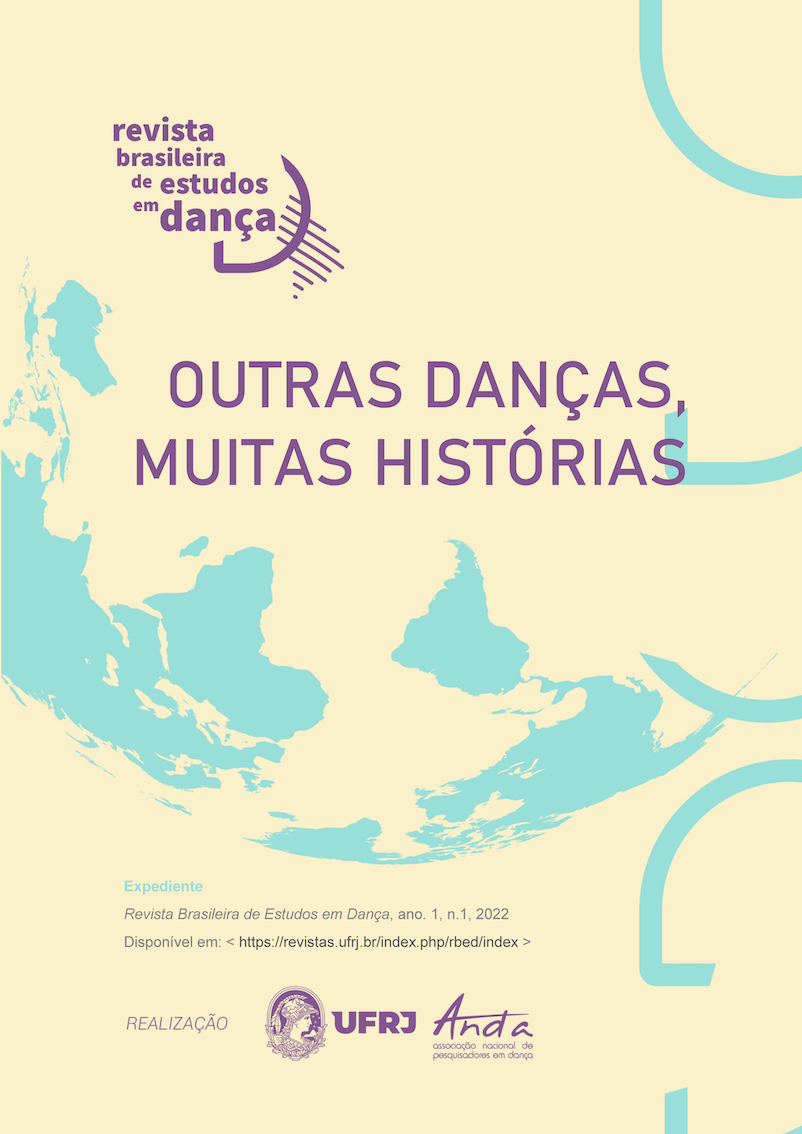Descolonizando a história da dança
DOI :
https://doi.org/10.58786/rbed.2022.v1.n1.53729Mots-clés :
história da dança, dança indiana, descolonizarRéférences
BANERJI, A. Odissi Dance: Paratopic Performances of Gender, Law, and Nation. Tese de Doutorado. New York: New York University, 2010.
BOSE, M. Speaking of Dance:The Indian Critique. New Delhi: D.K. Printword, 2001.
CHAKRAVORTY, P. Bells of Change: Kathak Dance,Women and Modernity in India, Calcutta: Seagull Books, 2008.
CHAKRAVORTY, P. Remixed Practice: Bollywood Dance and the Global Indian. In: CHAKRAVORTY, P; GUPTA, N. (eds.) Dance Matters: Performing India. New Delhi: Oxford University Press, 2010.
CHATTERJEA, A. Contestations: Constructing a Historical Narrative for Odissi. In: CARTER, A. (ed.) Rethinking Dance History: A Reader, London: Routledge, 2004, pp. 143–156.
CHATTERJEA, A. Red-Stained Feet: Probing the Ground on Which Women Dance in Contemporary Bengal. In: FOSTER, S.L. (ed.) Worlding Dance, Basingstoke: Palgrave Macmillan, 2009.
COORLAWALA, U.A. Classical and Contemporary Indian Dance: Overview, Criteria and a Choreographic Analysis. Tese de Doutorado. New York: New York University, 1994.
GRAMSCI, A. Selections from the Prison Notebooks. London: Lawrence and Wishart, 1971.
GUHA, R (ed.). Subaltern Studies:Writings on South Asian Society and History. New Delhi: Oxford University Press, 1982.
GUHA, R. (ed.) Dominance without Hegemony: History and Power in Colonial India, Cambridge, MA: Harvard University Press, 1997.
KEDHAR, A. Flexibility and Its Bodily Limits: Transnational South Asian Dancers in an Age of Neoliberalism. Dance Research Journal, 46:1, 23–40, 2014.
KERSENBOOM-STORY, S.C. Nityasumangali: Devadasi Tradition in South Asia, New Delhi: Motilal Banarsidass, 1987.
LOPEZ Y ROYO, A. Classicism, Post-Classicism and Ranjabati Sircar’s Work: Redefining the Terms of Indian Contemporary Dance Discourses. South Asia Research, 23:1, 2003, 153–169.
MEDURI, A. Rukmini Devi Arundale (1904–1986):AVisionary Architect of Indian Culture and the Performing Arts, New Delhi: Motilal Banarsidass, 2005.
O’SHEA, J. At Home in the World: Bharata Natyam on the Global Stage, Middle- town: Wesleyan University Press, 2007.
PURKAYASTHA, P. Indian Modern Dance, Feminism and Transnationalism, Basingstoke: Palgrave Macmillan, 2014.
PURKAYASTHA, P. Women in Revolutionary Theatre: IPTA, Labor, and Perfor- mance. Asian Theatre Journal, 32:2, 2015, pp. 518–535.
ROY CHOWDHURY, R. Jibaner Taney Shilper Taney, Calcutta: Thema, 1999.
SAID, E.W. Orientalism, New York: Vintage Books, 1995.
SARKAR MUNSI, U. Tale of the Professional Woman Dancer in Folk Traditions in India: Commodification of Dance and the Traditional Dancing Women. In: DUTT, B.; SARKAR Munsi, U. (eds.) Engendering Performance: Indian Women Performers in Search of an Identity. New Delhi: SAGE, 2010.
SETH, S. Which Past? Whose Transcendental Presupposition? Postcolonial Studies, 11:2, 2008, pp. 215–226.
SONEJI, D. Unfinished Gestures: Devadasis, Memory, and Modernity in South India, Chicago: University of Chicago Press, 2012.
SPIVAK, G.C. Can the Subaltern Speak. In: NELSON, C.; GROSSBERG, L. (eds.) Marxism and the Interpretation of Culture, Urbana: University of Illinois Press, 1988, pp. 271–313.
SRINIVASAN, A. Reform and Revival: The Devadasi and Her Dance. Economic and PoliticalWeekly, 20:44, 1985, pp. 1869–1876.
SRINIVASAN, P. Sweating Saris: Indian Dance as Transnational Labor, Philadelphia: Temple University Press, 2012.
VATSYAYAN, K. Indian Classical Dance, New Delhi: Ministry of Information and Broadcasting, Govt. of India, 1974.
Téléchargements
Publiée
Versions
- 2024-05-10 (3)
- 2023-11-30 (2)
- 2022-07-31 (1)
Comment citer
Numéro
Rubrique
Licence
Les auteurs qui publient dans la Revista Brasileira de Estudos em Dança sont responsables du contenu des articles signés et en conservent les droits d'auteur. Ils accordent au journal le droit de première publication avec le travail simultanément sous Creative Commons Atribuição-Não Comercial 4.0 License (Open Archives Initiative - OAI). Cette ressource, utilisée pour les revues en libre accès, permet de partager l'œuvre à des fins non commerciales avec mention de la paternité. Si le texte est publié ultérieurement dans une autre revue, l'auteur doit indiquer qu'il a été publié à l'origine comme article dans la Revista Brasileira de Estudos em Dança. Ainsi, même si la revue est propriétaire de la première publication, les auteurs ont le droit de publier leurs œuvres dans des dépôts institutionnels ou sur leurs pages web personnelles, même si le processus éditorial n'est pas terminé.
La revue se réserve le droit d'apporter des modifications normatives, orthographiques et grammaticales afin de maintenir le standard linguistique, en respectant toutefois le style de l'auteur.

